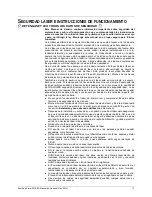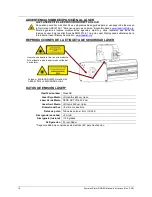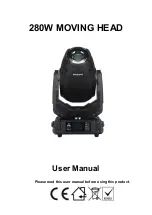
Scorpion Storm RGB EU User Manual (Rev. 2 ML)
3
L
ASER
S
AFETY AND
O
PERATING
I
NSTRUCTIONS
STOP AND READ ALL LASER SAFETY DATA
This User Manual contains important laser system safety and operation
information. Read and understand all instructions prior to powering on laser unit
the first time, to avoid laser eye injury and to avoid breaking the law. Keep this
manual in a safe place for future reference.
Laser light is different from any other light source you may be familiar with. The light from
this product can cause eye injury if the product is not set up and used properly.
Laser light is thousands of times more concentrated than light from any other source. This
concentration of light power can cause instant eye injuries, primarily by burning the retina
(the light-sensitive portion at the back of the eye). Even if you cannot feel “heat” from a
laser beam, it can still injure or blind you or your audience. Even very small amounts of
laser light are potentially hazardous—even at long distances. Laser eye injuries can
happen quicker than you can blink.
It is incorrect to think that because these laser entertainment products split the laser into
hundreds of beams, or because the laser beam is scanned out in high speed, that any
laser beam is safe for eye exposure. This laser product uses dozens of milliwatts of laser
power (Class 3B levels internally). Many of the individual beams are potentially hazardous
to the eyes.
It is also incorrect to assume that because the laser light is moving, it is safe. This is not
true. Nor do the laser beams always move. Since eye injuries can occur instantly, it is
critical to prevent the possibility of ANY direct eye exposure. In the laser safety regulation,
it is not legal to aim Class 3B lasers into areas in which people can be exposed. This is
true even if it is aimed below people’s faces, such as on a dance floor.
Do not operate laser without first reading and understanding all the safety and
technical data in this manual.
Always mount the product so that all laser effects so that all laser light is at least 3 m
(9.8 ft) above the floor on which people stand. See the
Proper Laser Set-up & Usage
section of this manual.
After set up, and prior to public use, test laser to ensure proper function. DO NOT use
if any defect is detected. DO NOT use if laser emits only one or two laser beams rather
than dozens/hundreds, as this could indicate damage to the diffraction grating optic,
and could allow emission of higher laser levels.
DO NOT point lasers at people or animals.
Never look into the laser aperture or laser beams.
DO NOT point lasers in areas in which people can potentially be exposed, such as
balconies, etc.
DO NOT point lasers at highly reflective surfaces such as windows, mirrors and shiny
metal. Even laser reflections can be hazardous.
Never point a laser at aircraft, this is a U.S. federal offense.
Never point unterminated laser beams into the sky.
DO NOT expose the output optic (aperture) to cleaning chemicals.
DO NOT use if housing is damaged or open, or if optics appear damaged in any way.
NEVER open the laser housing. The high laser power levels inside of the protective
housing can start fires, burn skin, and will cause instant eye injury.
NEVER leave this device running unattended.
The operation of a Class 3B laser show laser is only allowed if the show is controlled
by a skilled and well-trained operator familiar with the data included in this manual.
The legal requirements for using laser entertainment products vary from country to
country. The user is responsible for observing the laws in the location/country of use.
Always use appropriate lighting safety cables when hanging lights and effects
overhead.
LASER EXPOSURE WARNING
LASER LIGHT AVOID DIRECT EYE EXPOSURE
Further guidelines and safety programs for safe use of lasers can be found in the ANSI Z136.1
Standard “For Safe Use of Lasers,” available from
www.laserinstitute.org
. Many local governments,
corporations, agencies, military, and others, require all lasers to be used under the guidelines of
ANSI Z136.1. Laser Display guidance can be obtained via the International Laser Display
Association,
www.laserist.org
.




































